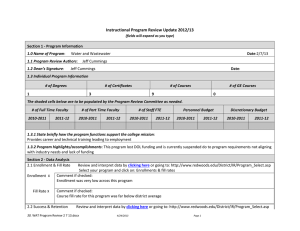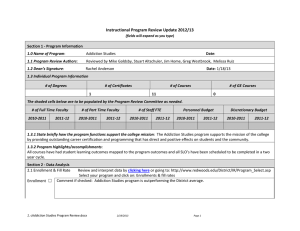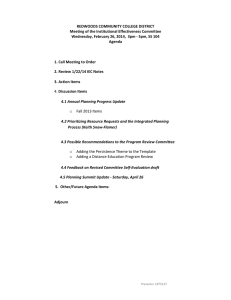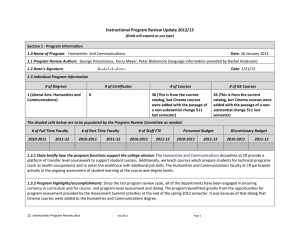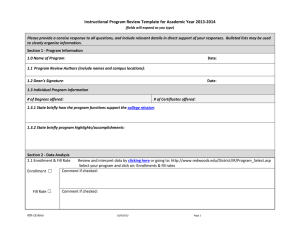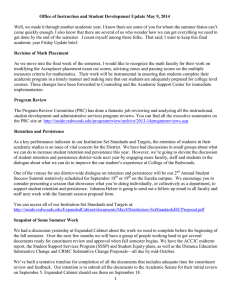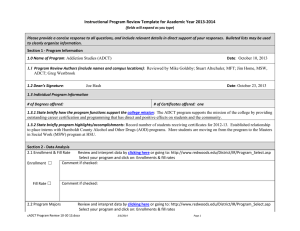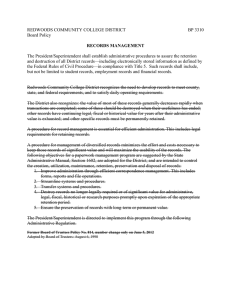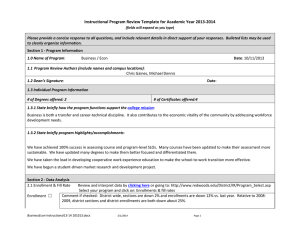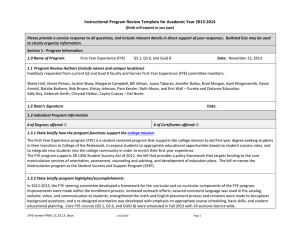Jeff A. Cummings Instructional Program Review Update 2012/13
advertisement
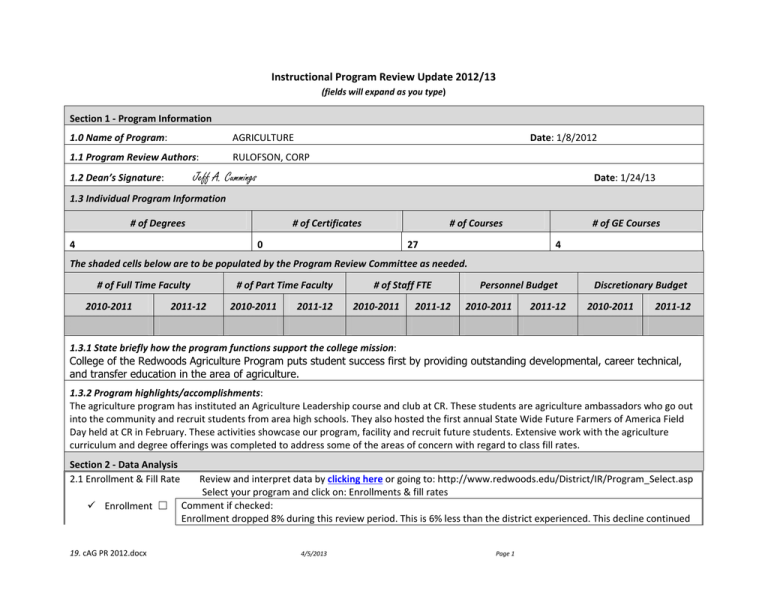
Instructional Program Review Update 2012/13 (fields will expand as you type) Section 1 ‐ Program Information 1.0 Name of Program: AGRICULTURE Date: 1/8/2012 1.1 Program Review Authors: RULOFSON, CORP 1.2 Dean’s Signature: Jeff A. Cummings Date: 1/24/13 1.3 Individual Program Information # of Degrees # of Certificates 4 # of Courses 0 # of GE Courses 27 4 The shaded cells below are to be populated by the Program Review Committee as needed. # of Full Time Faculty 2010‐2011 2011‐12 # of Part Time Faculty 2010‐2011 2011‐12 # of Staff FTE 2010‐2011 2011‐12 Personnel Budget 2010‐2011 Discretionary Budget 2011‐12 2010‐2011 2011‐12 1.3.1 State briefly how the program functions support the college mission: College of the Redwoods Agriculture Program puts student success first by providing outstanding developmental, career technical, and transfer education in the area of agriculture. 1.3.2 Program highlights/accomplishments: The agriculture program has instituted an Agriculture Leadership course and club at CR. These students are agriculture ambassadors who go out into the community and recruit students from area high schools. They also hosted the first annual State Wide Future Farmers of America Field Day held at CR in February. These activities showcase our program, facility and recruit future students. Extensive work with the agriculture curriculum and degree offerings was completed to address some of the areas of concern with regard to class fill rates. Section 2 ‐ Data Analysis 2.1 Enrollment & Fill Rate Review and interpret data by clicking here or going to: http://www.redwoods.edu/District/IR/Program_Select.asp Select your program and click on: Enrollments & fill rates Enrollment ☐ Comment if checked: Enrollment dropped 8% during this review period. This is 6% less than the district experienced. This decline continued 19. cAG PR 2012.docx 4/5/2013 Page 1 into Fall 2012/13. Comment if checked: Fill Rate ☐ Several courses had below average fill rates. These courses have been evaluated and several of them have been inactivated during the 2012/13 year. The courses inactivated include AG 39, AG 40, AG 12, AG 6, and AG 18. AG 19, 22, 52, 31, 33, and 36 will be inactivated as well. This will allow the remaining agriculture courses to be taught each year instead of the every other year pattern many courses have been on. All Courses being taught are now requirements for the degree. By eliminating the electives all courses will now be needed and therefore should fill. 2.2 Success & Retention Review and interpret data by clicking here or going to: http://www.redwoods.edu/District/IR/Program_Select.asp Select your program and click on: Success & Retention Success ☐ Comment if checked: Student success has improved during this review period. The success and retention of agriculture students is now slightly better than district wide. Retention ☐ Comment if checked: Student retention has improved during this review period. The success and retention of agriculture students is now slightly better than district wide. 2.3 Persistence Review and interpret data by clicking here or going to: http://www.redwoods.edu/District/IR/Program_Select.asp Select your program and click on: Persistence ☐ Comment: The agriculture program has been working to improve persistence in our students. This review period show a 9% increase. However, we are still below the district average. Having redesigned our curriculum and degrees will help the future students to complete in a timely manner. No more courses will be offered on an every other year basis. 2.4 Completions Review and interpret data by clicking here or going to: http://www.redwoods.edu/District/IR/Program_Select.asp Select your program and click on: Completions & Transfers ☐ Comment: 19. cAG PR 2012.docx 4/5/2013 Page 2 Student Equity Group Data 2.5 Enrollments Review and interpret data by clicking here or going to: http://www.redwoods.edu/District/IR/Program_Select.asp by group Select your program and click on ~ by Student Equity Group next to Enrollments & fill rates Comment: 2.6 Success & Retention Review and interpret data by clicking here or going to: http://www.redwoods.edu/District/IR/Program_Select.asp by group Select your program and click on ~ by Student Equity Group next to success & retention Comment: 2.7 Persistence Review and interpret data by clicking here or going to: http://www.redwoods.edu/District/IR/Program_Select.asp by group Select your program and click on ~ by Student Equity Group next to persistence Comment: The agriculture program has been working to improve persistence in our students. This review period show a 9% increase. However, we are still below the district average. Having redesigned our curriculum and degrees will help the future students to complete in a timely manner. No more courses will be offered on an every other year basis. Additional Indicators 2.8 Faculty Information Review and interpret data by clicking here or going to: http://www.redwoods.edu/District/IR/Program_Select.asp Select your program and click on: Faculty (FT/PT) & FTES/FTEF Comment: 2.9 Labor Market Data (CTE/Occupational programs only) Refer to the California Employment Development Division: http://www.edd.ca.gov/ www.labormarketinfo.edd.ca.gov Provide a narrative that addresses the following: a. Documentation of labor market demand b. Non‐duplication of other training programs in the region 19. cAG PR 2012.docx 4/5/2013 Page 3 c. Effectiveness as measured by student employment and program completions. Narrative: According to the California Employment Development Department Website, agriculture employment opportunities will continue to be strong. Farm labor positions will increase 2.7% over 10 years and positions for landscapers and tree trimmers are among the fastest growing occupations with 27.2 and 9.5% increases projected respectively. In the animal field employment looks bright as well with animal caretakers and veterinary technician positions increasing 31.1 and 31% respectively. CR is positioned well being the only provider of agriculture training in our area. Students who earn the AS.AG General Degree are positioned well for starting positions in the agriculture field. Those who transfer to and complete a four‐year program will start at a higher salary. Overall, what has been the impact of the change in indicators on student achievement and learning: The overall trend in these indicators has been in a positive direction. However, there is still improvement to be made. Changes to the curriculum and degrees should help to maintain this positive direction. Provide narrative on the factors that may have contributed to the improvement or decline in the identified population: The agriculture leadership program has helped with program recruitment. These students serve as agriculture ambassadors who go out to local high schools to recruit students. These efforts are giving positive results. The agriculture curriculum has been revised and an updated degree was recently approved. Many agriculture courses have been inactivated. The remaining courses are all required for the degree and will be offered every year instead of having many of them being offered on an every other year basis. These changes will help improve fill rates since there will be fewer course offerings each semester. Our student success has improved and will continue to improve as a result of these changes. Section 3 – Critical Reflection of Assessment Activities Curriculum & Assessment Data Are all courses on track for complete assessment of all outcomes in two years? Y/N What courses, if any, are not on track with regard to assessment? Explain. # of PLOs Assessed and Reported during the 2011‐2012 academic year. % of Course Outlines of Record updated If there is no plan for updating outdated curriculum, when will you inactivate? View curriculum status: click here or go to: http://www.redwoods.edu/District/IR/Program_Select.asp Select your program and click on: Curriculum Status Assessment Reporting completed? Y/N Program Advisory Committee Met? Y/N 19. cAG PR 2012.docx 4/5/2013 Page 4 Yes N/A 7 PLOs Covering three degrees 100% Yes Yes 3.0 How has assessment of course level SLO’s led to improvement in student learning (top three): 1. Has helped identify areas where more instruction is needed. 2. Has identified poorly written SLO’s and have had the opportunity to rewrite them 3. Has identified areas of strength that can be built upon. 3.1 How has assessment of program level outcomes led to degree/certificate improvement (top three): 1. Has helped to align slo’s with plo’s. 2. Has led to the development of a certificate of recognition. 3. Has helped us to see how important each course is to the degree. 3.2 (Optional) Describe unusual assessment findings/observations that may require further research or institutional support: Section – 4 Evaluation of Previous Plans 4.1 Describe plans/actions identified in the last program review and their current status. What measurable outcomes were achieved due to actions completed. Actions Current Status Outcomes Revise/update curriculum complete Updated six courses Revise/update degrees complete Revised two degrees Build Livestock Handling facility Waiting for measure Q funds n/a 4.2 (If applicable) Describe how funds provided in support of the plan(s) contributed to program improvement: Section – 5 Planning 5.0 Program Plans (2012/2013) Based on data analysis, student learning outcomes and program indicators, assessment and review, and your critical reflections, describe the program’s Action Plan for the 2012/13 academic year. If more than one plan, add rows. Include necessary resources. (Only a list of resources is needed here. Provide detailed line item budgets, supporting data or other justifications in the Resource Request). 19. cAG PR 2012.docx 4/5/2013 Page 5 The agriculture program will look at inactivating courses that are not critical to the AS.AG. General or AA.LA. Ag degrees. There are too many course offerings and it makes it hard for students to complete when many courses are offered every other year. The AS.AG. General or AA.LA. Ag degrees will be revised to reflect these changes. The following curriculum will be updated: AG 23, AG 7, and AG 35. The livestock handling facility will hopefully be built and incorporated into the curriculum. This facility will be used in all animal science courses and the sustainable agriculture labs. Facilities will also be upgraded in the plant science and soils lab. 5.1 Program Plans Relationship to Institutional Plans Inactivation of agriculture classes Improve academic programs to support student success. Improve academic Revise degrees programs to support student success. Improve academic Update Curriculum programs to support student success. Improve academic Build Livestock handling facility programs to support student success. Action to be taken: Upgrade plant science and soils lab. Improve academic programs to support student success. Relationship to Assessment Low fill rates Expected Impact on Program/Student Learning Improve fill rates, retention, and persistence Program learning outcomes Improve retention and persistence along with degree completers. Maintain and update current technologies and methodologies Produce better trained and qualified students for the agriculture workplace. Student Learning outcomes Animal science courses need a facility where students can handle the livestock. Student learning outcomes Resources Needed None None None 150,000 (approved last year – funds on hold) Students get a more hands‐on 7000 (CETA experience with the use of the funded) laboratory equipment 5.2 Provide any additional information, brief definitions, descriptions, comments, or explanations, if necessary. Section 6 ‐ Resource Requests 6.0 Planning Related, Operational, and Personnel Resource Requests. Requests must be submitted with rationale, plan linkage and estimated costs. Request Check One Amount Recurring Rationale 19. cAG PR 2012.docx 4/5/2013 Page 6 Livestock Handling Facility Planning Operational Personnel $ 150,000 Cost Y/N Y Linkage Approved last year but on hold until measure Q funds are released. Section 7‐ Program Review Committee Response Do not type in this section. To be completed by the Program Review Committee following evaluation. 7.0 The response will be forwarded to the author and the supervising Director and Vice President: S.1. Program Information: Satisfactory S.2. Data Analysis: Number of sections increased, enrollments have declined. Fill rates are significantly less than the district; but those courses have been evaluated and several inactivated. Persistence is below average, but narrative indicates the program, restructured last year, will increase persistence. Completion numbers are small – as yet no AG AS degree from 2007‐2010, or 2008‐2011. Other degrees have some completions or transfers. No comment on this. Equity data show the Mendocino Hispanic population is reported at 17% while the program reported only 3%. This might be a good population to target for program expansion. Good report on labor market trends. Report suggests a growth in areas of farm labor and animal husbandry. PRC recommends, in the future, responding to the student equity data‐there were definitely differences that should be identified or commented on. S.3. Critical Reflection of Assessment Activities: Seven PLOs assessed over three degrees. Outlines up to date; assessment reported; advisory committee met. How assessment led to improvement vague; Same with 3.2 More elaboration needed/Should be more detailed in future. S.4. Evaluation of Previous Plans: Addressed and included outcomes. S.5. Planning: PRC noted there should be some clarification between the previous curriculum and degree revisions and the current. Better linkage to institutional planning and/or assessment is recommended for future reviews. S.6. Resource Requests: Resource requests have been previously approved and funded through CTEA and Measure Q; program waiting for release of funds. 19. cAG PR 2012.docx 4/5/2013 Page 7
